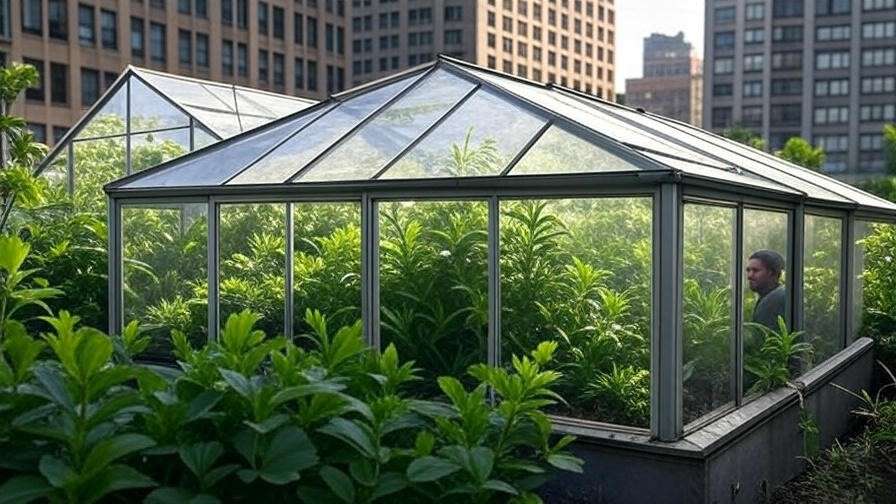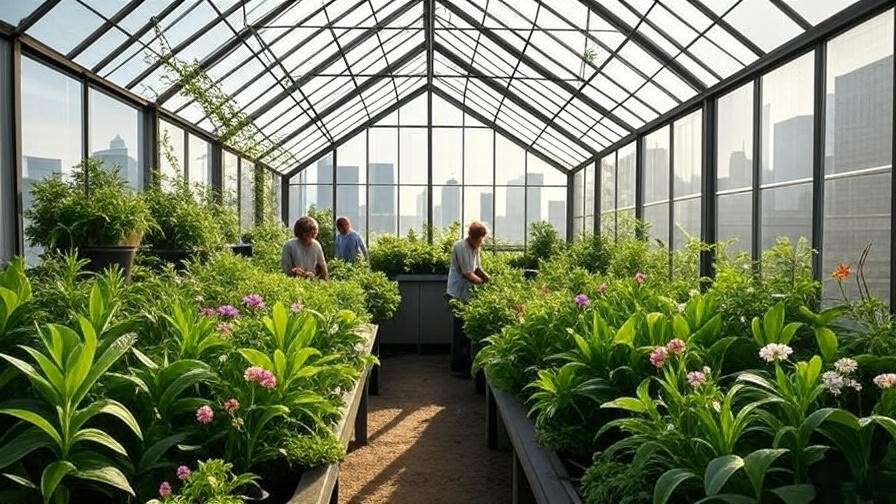Imagine transforming a barren city rooftop into a lush, green oasis that feeds your community year-round. Rooftop greenhouses promise just that—a sustainable solution to urban food scarcity. Yet, the dream of urban farming comes with hidden pitfalls. Understanding rooftop greenhouse disadvantages is crucial for anyone considering this innovative approach. From sky-high costs to structural limitations, these challenges can make or break your urban agriculture venture. As an agricultural consultant with over a decade of experience in urban farming, I’ve seen both successes and failures. This comprehensive guide dives deep into the drawbacks, backed by expert insights and real-world examples, to help you make informed decisions. Whether you’re a budding urban farmer or a seasoned grower, you’ll discover practical strategies to navigate these hurdles and decide if rooftop greenhouses are right for you.
What Are Rooftop Greenhouses and Why Are They Popular?
Definition and Overview
Rooftop greenhouses are controlled-environment structures built on urban building rooftops to grow crops year-round. Unlike traditional greenhouses, they maximize underutilized urban spaces, offering a solution to land scarcity in cities. These structures use advanced systems like hydroponics, climate control, and irrigation to produce fresh produce, from leafy greens to tomatoes, regardless of season. Their appeal lies in their ability to bring farming closer to consumers, reducing transportation emissions and ensuring fresher food.
The Growing Trend in Urban Farming
Urban agriculture is booming. According to a 2023 report by the Food and Agriculture Organization, urban farming now contributes to 15-20% of global food production. Rooftop greenhouses are at the forefront, adopted in cities like New York, Singapore, and Tokyo. They align with sustainability goals, support local economies, and appeal to eco-conscious consumers. However, their popularity often overshadows significant challenges, which we’ll explore next.
Key Rooftop Greenhouse Disadvantages
High Initial and Operational Costs
One of the most daunting rooftop greenhouse disadvantages is the cost. Building a rooftop greenhouse requires substantial investment. Structural reinforcements to support the weight of the greenhouse, soil, and equipment can cost $50,000-$100,000 for a modest setup, according to a 2024 urban agriculture study by Cornell University. High-quality materials like UV-resistant glazing and automated climate systems add to the expense. Operational costs are equally steep—energy for heating, cooling, and lighting can account for 30-40% of monthly expenses. For example, a 1,000-square-foot rooftop greenhouse in Chicago reported annual energy costs exceeding $15,000. These figures often deter small-scale farmers, making profitability a challenge without significant upfront capital or grants.
Structural and Engineering Limitations

Rooftop greenhouses face unique structural hurdles. Most urban buildings aren’t designed to support heavy loads, requiring costly engineering assessments and reinforcements. Dr. Sarah Thompson, a structural engineer specializing in urban agriculture, notes, “Retrofitting a rooftop for a greenhouse can cost as much as the greenhouse itself if the building’s foundation isn’t robust.” Wind loads are another concern—high-rise rooftops face stronger winds, increasing risks of structural damage. Drainage issues also arise, as poor water management can lead to leaks or building damage. Compliance with local building codes further complicates projects, often requiring expensive modifications.
Energy and Resource Demands
Rooftop greenhouses are resource-intensive. Climate control systems, essential for year-round production, consume significant energy. In colder climates, heating can account for 50% of energy use, while cooling dominates in warmer regions. Water usage is another concern—hydroponic systems, common in rooftop setups, require consistent irrigation, and inefficiencies can spike costs. A 2022 study by the University of Toronto found that rooftop greenhouses use 20-30% more water per crop yield than traditional farms due to evaporation and system leaks. Tip: Consider solar panels or rainwater harvesting to offset energy and water demands, though these add to initial costs.
Limited Space and Scalability
Space constraints are a significant drawback. Even large rooftops offer limited growing area compared to rural farms, restricting crop variety and yield. For instance, a 2,000-square-foot rooftop might support only 500-600 plants, insufficient for commercial-scale production. Scaling up is challenging—adding more greenhouses requires additional structural upgrades, which may not be feasible. A rooftop farm in Brooklyn struggled to meet local restaurant demands due to its limited 1,500-square-foot space, highlighting scalability issues.
Maintenance and Accessibility Challenges
Maintaining a rooftop greenhouse is no small feat. Accessing the rooftop for daily tasks or repairs can be cumbersome, especially in multi-story buildings without elevators. Harsh weather—UV exposure, heavy rain, or snow—accelerates wear on greenhouse materials, requiring frequent replacements. For example, polycarbonate panels may need replacing every 5-7 years due to UV degradation, costing thousands. Storms pose additional risks, as seen in a 2023 Montreal rooftop greenhouse damaged by high winds, leading to $20,000 in repairs.
Regulatory and Zoning Hurdles
Navigating regulations is a major obstacle. Zoning laws vary widely by city, and many restrict rooftop greenhouses due to safety or aesthetic concerns. In San Francisco, for instance, farmers must secure permits costing $1,000-$5,000, plus comply with fire and building codes. Delays in approvals can stall projects for months. A 2024 survey by the Urban Agriculture Network found that 60% of rooftop greenhouse projects faced regulatory delays, discouraging investment.
Environmental and Social Concerns
Rooftop greenhouses can raise environmental and social issues. Noise from ventilation systems or pumps may disturb neighbors, leading to complaints. Light pollution from grow lights can also be a concern in densely populated areas. Improper waste management, like pesticide runoff, risks contaminating urban water systems. Additionally, community pushback can arise if projects are seen as gentrifying or increasing local property costs. These concerns require careful planning to maintain good community relations.
Comparing Rooftop Greenhouses to Other Urban Farming Methods
Rooftop Greenhouses vs. Vertical Farms

Rooftop greenhouses and vertical farms both aim to maximize urban spaces, but their challenges differ. Vertical farms, often housed indoors, use stacked growing systems with artificial lighting, offering greater space efficiency. A 2024 study by the Urban Farming Institute found vertical farms can produce 2-3 times more yield per square foot than rooftop greenhouses due to multi-level designs. However, vertical farms require even higher energy inputs for lighting, often exceeding rooftop greenhouse costs by 20%. Rooftop greenhouses benefit from natural sunlight, reducing lighting expenses, but face unique structural constraints not applicable to vertical farms. For example, a vertical farm in Singapore scaled to 10,000 square feet indoors, while a rooftop greenhouse on a nearby building was capped at 2,000 square feet due to weight limits.
Rooftop Greenhouses vs. Community Gardens
Community gardens offer a low-cost alternative to rooftop greenhouses, relying on open-air plots without complex infrastructure. They foster community engagement and require minimal setup—often just $1,000-$5,000 for soil and tools, compared to $50,000+ for a greenhouse. However, community gardens lack climate control, limiting year-round production. A community garden in Chicago produced diverse crops but only during a 6-month growing season, while a nearby rooftop greenhouse maintained year-round output despite higher costs. Community gardens also face land access issues, but they avoid the structural and regulatory hurdles of rooftop setups. Choosing between them depends on budget, goals, and access to resources.
Mitigating Rooftop Greenhouse Challenges
Cost-Saving Strategies
High costs can be a dealbreaker, but strategic planning helps. Modular greenhouse designs, using lightweight materials like aluminum frames, can reduce initial expenses by 15-20%, according to a 2023 report by the Urban Agriculture Research Group. Seeking grants, such as those from the USDA’s Urban Agriculture Program, can offset costs—some farmers secure up to $25,000 in funding. Crowdfunding platforms like Kickstarter have also supported urban farming projects, with one New York greenhouse raising $30,000 from community backers. Tip: Invest in energy-efficient systems, like LED grow lights or insulated glazing, to cut long-term operational costs by up to 30%.
Engineering and Design Solutions
Addressing structural limitations requires foresight. Lightweight materials, such as polycarbonate panels over glass, reduce building stress while maintaining durability. Pre-construction assessments by a structural engineer are critical—Dr. Maria Gonzalez, an urban agriculture architect, recommends budgeting $5,000-$10,000 for assessments to avoid costly retrofits. Designing for wind resistance, like using aerodynamic shapes, minimizes damage risks. Proper drainage systems, such as sloped roofing and gutter integration, prevent water damage. These solutions, while adding upfront costs, ensure long-term stability and compliance with building codes.
Navigating Regulations
Regulatory hurdles can delay or derail projects, but preparation helps. Research local zoning laws early—cities like Toronto publish urban farming guidelines online. Engage with city planners to understand permit requirements, which may include fire safety or structural certifications. For example, a Seattle rooftop greenhouse secured permits in three months by working closely with the city’s planning department. Joining urban agriculture networks, like the National Sustainable Agriculture Coalition, provides access to advocacy resources and legal guidance. Tip: Hire a consultant familiar with local regulations to streamline approvals.
Sustainable Practices

Sustainability mitigates resource demands. Solar panels can reduce energy costs by 20-40%, though installation costs $10,000-$20,000. Rainwater harvesting systems, costing as little as $2,000, cut water bills and address urban runoff concerns. Hydroponics, while water-intensive, can be optimized with closed-loop systems to reduce waste by 25%, per a 2024 study by MIT’s Urban Farming Lab. Companion planting—pairing crops like tomatoes and basil—maximizes limited space, boosting yields by 10-15%. These practices not only lower costs but also enhance environmental credibility, appealing to eco-conscious consumers.
Case Studies: Real-World Rooftop Greenhouse Challenges
Case Study 1: Urban Farm Failure

In 2022, a rooftop greenhouse in Philadelphia aimed to supply local restaurants but collapsed under financial and structural strain. The project, costing $80,000 to build, underestimated the need for structural reinforcements on a 50-year-old building. High energy costs—$1,500 monthly for heating—further eroded profits. Regulatory delays, including a six-month wait for permits, drained resources. The farm shut down within a year, highlighting the risks of inadequate planning and underestimating rooftop greenhouse disadvantages.
Case Study 2: Overcoming Challenges
Contrastingly, a rooftop greenhouse in Montreal thrived by addressing challenges proactively. The project, launched in 2021, used lightweight materials and secured a $20,000 grant to offset costs. Solar panels reduced energy expenses by 30%, and a partnership with a local university provided regulatory guidance, speeding up approvals. By focusing on high-value crops like microgreens, the farm achieved profitability within 18 months. This success underscores the value of strategic planning and resource optimization.
FAQs About Rooftop Greenhouse Disadvantages
- What are the biggest disadvantages of rooftop greenhouses?
High costs, structural limitations, energy demands, and regulatory hurdles top the list. Limited space and maintenance challenges also pose significant barriers. - How much does it cost to build a rooftop greenhouse?
Costs range from $50,000-$100,000 for a small setup, with operational expenses like energy adding $10,000-$20,000 annually. - Are rooftop greenhouses safe for urban buildings?
They can be safe with proper engineering assessments and reinforcements, but older buildings may require costly upgrades. - Can rooftop greenhouses be profitable despite their challenges?
Yes, with high-value crops, grants, and efficient systems, but profitability requires careful planning and cost management. - How can I reduce energy costs in a rooftop greenhouse?
Use solar panels, LED lighting, and insulated materials to cut energy use by 20-40%.
Conclusion
Rooftop greenhouses offer a visionary approach to urban farming, but their disadvantages—high costs, structural constraints, energy demands, and regulatory hurdles—demand careful consideration. By understanding these challenges, urban farmers can make informed decisions and avoid costly pitfalls. Strategies like modular designs, sustainable practices, and regulatory preparedness can mitigate risks, as seen in successful projects like Montreal’s rooftop farm. Before embarking on your rooftop greenhouse journey, consult structural engineers, research local regulations, and explore funding options. Have you faced rooftop farming challenges or found innovative solutions? Share your experiences in the comments below—we’d love to hear your story!









